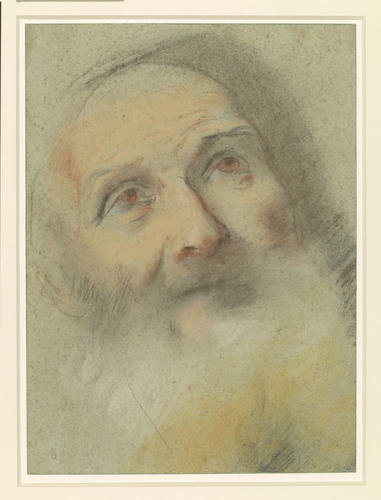-
1 of 253523 objects
The head of an old man c.1575
Black, white and coloured chalks on pale blue-green paper | 34.6 x 25.4 cm (whole object) | RCIN 905232

Federico Barocci (Urbino c. 1535-Urbino 1612)
The head of an old man c.1575
-
A drawing of a head of a venerable, bearded man, looking up to the right.
H. Olsen (FB, 1962, p. 169) first proposed that this might be a study for the prominently silhouetted figure in the centre-left background of Barocci’s Madonna del Popolo, and this suggestion has been generally accepted. The Madonna del Popolo was painted for the chapel of the Confraternità dei Laici di Santa Maria Misericordia in the church of Santa Maria della Pieve, Arezzo. Negotiations for the painting began in 1574, though it was not until the following summer that Barocci could be persuaded to visit Arezzo to inspect the proposed site for the painting. In a letter to his patrons of February 1576 he stated that he had finished all of his drawings and had almost finished his cartoon, thus dating the preparatory work to the autumn and winter of 1575-6. In 1578, worried about the progress of the painting, one of the confraternity visited Barocci in his studio in Urbino; a dispute over payment took up much of that year, and the painting was finally dispatched in 1579. It was transferred to the Uffizi in 1786.
There are in fact several old bearded men looking up in the hazy background of the painting, none of whom corresponds exactly with this head. This rather wizened old man recurs frequently in Barocci’s paintings and drawings (he was probably the model of 905233 as well), and A. Emiliani (FB, 1985, figs. 270-78) reproduced several such drawn heads as possible studies for the painting. The staffage of the painting is very different in the lower register from that of Barocci’s modello (at Chatsworth), and Barocci must have continued to consider the role and form of the bystanders even after he had completed the modello.
A chronic illness restricted Barocci’s painting activity to short periods in the morning and evening. But he was a prolific draughtsman, and used coloured chalks more extensively than any other artist before the eighteenth century, allowing him to determine both lighting and colour in a preparatory sheet. In addition to the sheer number of drawings by Barocci that are known, his graphic oeuvre is notable for two types of study that find few parallels in the works of his contemporaries. These are his modelli, the large, highly pictorial compositional drawings in pen, wash and white on toned paper, which survive for most of his larger paintings; and his head studies, such as this one, in coloured chalks, both natural and fabricated, which he exploited more extensively than any artist before the eighteenth century. This medium allowed him to determine both lighting and colour in the preparatory sheet, and thus he could use his precious painting time as efficiently as possible.
A. Emiliani, Federico Barocci, 1975, no. 103
D. Scrase, Federico Barocci in British Collections, exh. cat. Fizwilliam Museum, Cambridge, 2006, no. 41
M. Clayton, The Art of Italy in the Royal Collection: Renaissance and Baroque, London 2007, no. 53.Provenance
Listed in George III’s ‘Inventory A’, c.1800-20, p. 124, ‘Frederico Barocci’, among ‘13. Of Study’s of Heads’ (905222-34)
-
Creator(s)
-
Medium and techniques
Black, white and coloured chalks on pale blue-green paper
Measurements
34.6 x 25.4 cm (whole object)
Object type(s)
Other number(s)